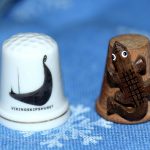It is unlikely that you will meet a person who does not know what a thimble is. This protective cap is used by both skilled sewers and ordinary people who ever need to mend a pocket or sock. However, the thimble is not as simple as it might seem at first glance. What secrets does its history keep, and has it always been used for its intended purpose? Well, let's figure it out.

Thimble - definition
A thimble is a cap that is placed on the finger to protect it from needle sticks when sewing.
Word thimble derived from on + finger (literally - on your finger). In Russian it is thimble, in Belarusian - naparstak, Ukrainian - thimble, Bulgarian - supervisor, Polish - naparstek, Czech - naprstek.
Metal is often used for manufacturing, but there are also plastic products, which, however, are not so durable and practical: they wear out faster and cannot always protect your hands.
The thimble is used to push the needle through fabric, usually dense and thick.There are small indentations on its top and part of the body to prevent the needle from slipping.

The thimble is usually placed on the index finger, but this is not so categorical - each person proceeds from his own convenience and comfort.
There are also through thimbles, which are considered a tool for tailors. They also make ring-shaped models, which are convenient to use if the craftswoman has long nails.
Story
This protective cap has been known since the 17th century, however, it is possible that it was used before. True, the materials used could have been slightly different.

Types of thimbles
Today in specialized stores you can find a large selection of auxiliary accessories that make the seamstress’s job easier. Conventionally, they are divided into decorative and functional. But even the first ones are able to perform their task with five points, since nothing interferes with the work.

At the same time, products may differ from each other not only in appearance, but also in functionality:
- Simple models are a blind cap that is placed on the finger. It has small indentations that prevent the needle from slipping. In fact, nothing remarkable.
- The ring is an open version without a top. Great for side needle pushing.
- For felting - it has a special coating that prevents slipping. Ideal for felting small parts.
- Ergonomic - an innovative model that provides high comfort while sewing. Its base is made of soft plastic, and the tip is made of hard plastic.
- Leather is a convenient device with a metal plate. Designed for long-term work as it allows the finger to breathe while protecting it from damage.
- Anti-slip - made of rubber.
- For quilting - adjustable size to fit all fingers.
- Anti-rotation - metal tip with a grooved surface. The base of the thimble is made of soft rubber.
- For knitting - they have yarn guides and are ideal for distributing threads of different shades.

@imall.com
The thimble is selected according to the size (thickness) of the finger of the hand with which the person is accustomed to working.

This is what it is - a simple cone-shaped cap, which is nevertheless very useful for sewing, knitting, and quilting.














 0
0





